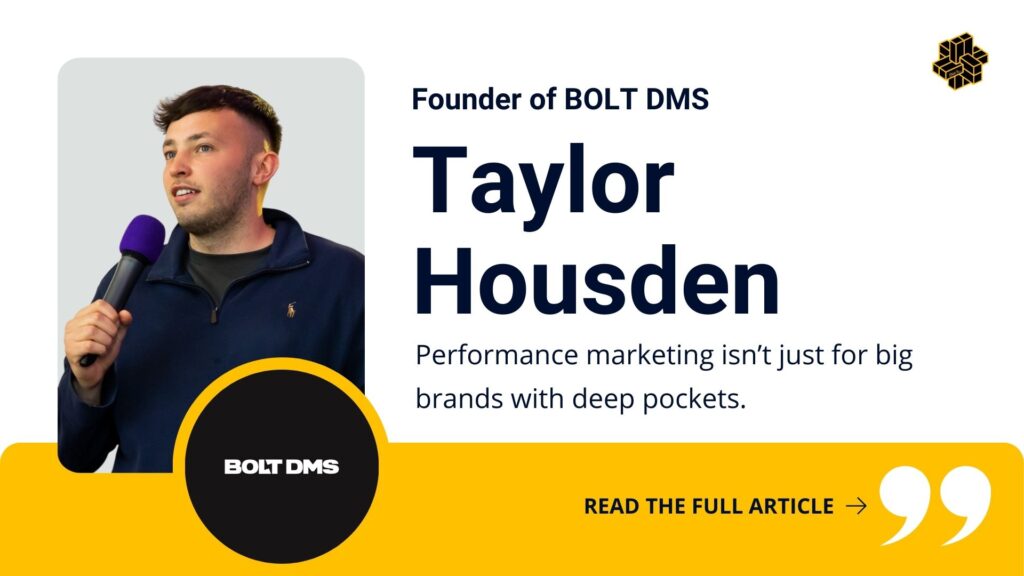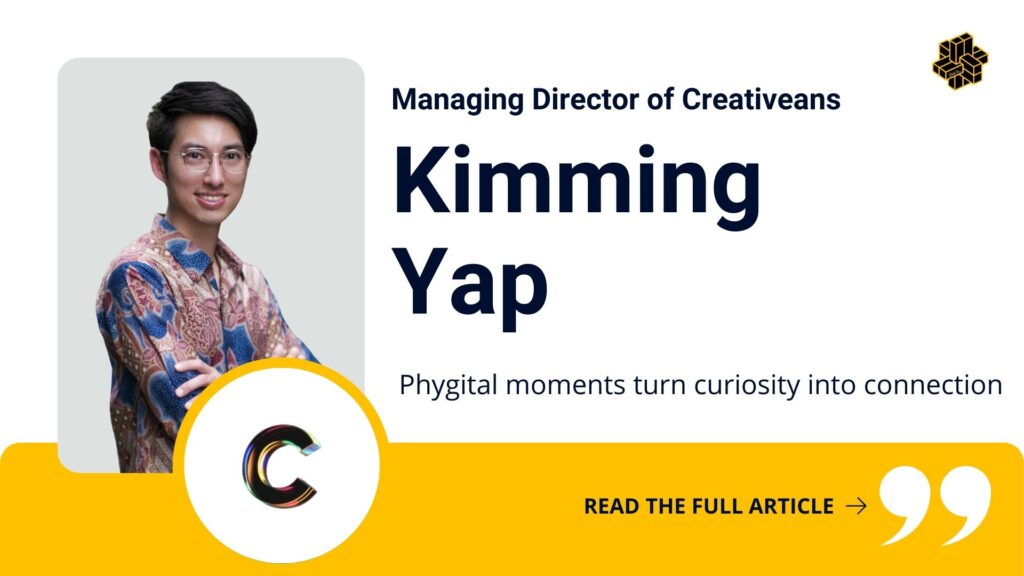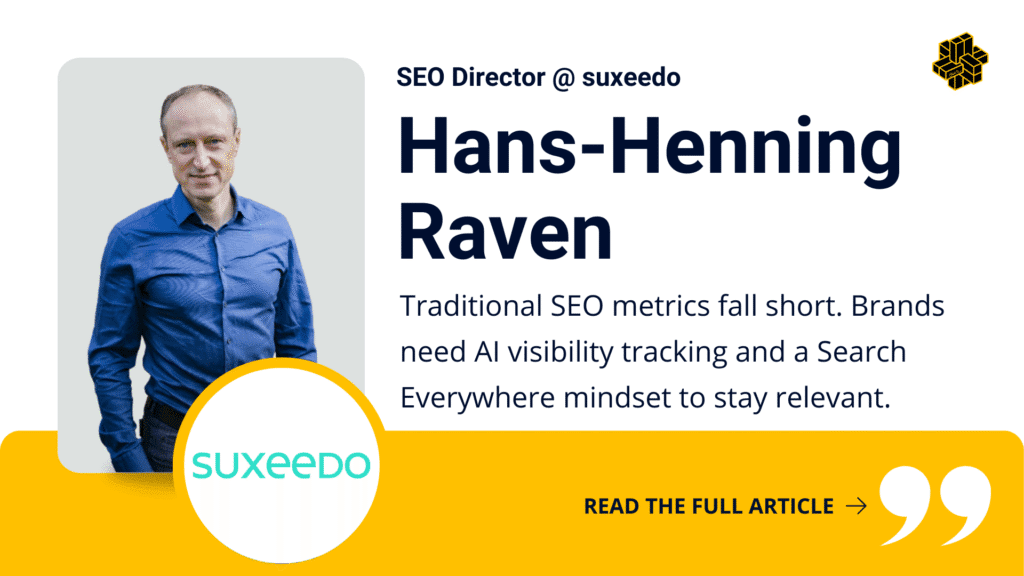
The way people search online is undergoing a seismic transformation. Gone are the days of typing a query and clicking through results; today, generative AI tools like ChatGPT, Perplexity, and Google’s AI Overviews are reshaping expectations. Users now demand instant, conversational answers – often without leaving the search engine itself. This shift doesn’t just disrupt SEO; it redefines how brands must measure visibility, engagement, and long-term trust in an AI-first world.
About the Author:
Hans-Henning Raven is Director SEO at the Digital Marketing Agency suxeedo and a seasoned expert with over 20 years of experience in the field. He has shaped and executed SEO strategies for some of Germany’s largest websites, including Lieferando.de (Just Eat), ImmobilienScout24, and GIGA.de. At suxeedo, he works with international clients to develop holistic, data-driven SEO and content strategies tailored to today’s evolving search landscape. His expertise spans the intersection of search, brand visibility, and AI – making him a sought-after speaker and consultant in the digital marketing industry..
How AI is Changing Search Behaviour – And How to Measure It
Search used to be straightforward: type a query, scroll results, click a link. Simple, right? Not anymore. With the rise of generative AI like ChatGPT, Perplexity, and Google’s AI Overviews, users now expect instant answers: precise, conversational, and often without leaving the search engine. Welcome to the era of zero-click search.
Why does this matter? It’s not just an SEO issue. Whether you’re in marketing, branding, or simply looking to maintain your company’s visibility online, this shift directly impacts your audience reach and brand perception. Your content might rank, but if users no longer click through, your traditional metrics and strategies need to adapt.
As someone who has navigated more than two decades of changes in SEO, I’ve seen shifts come and go, but none quite like this. It’s clear: brands must rethink their approach to content creation and measurement frameworks. In this article, I’ll guide you through this new landscape by providing practical insights and strategies to not just survive, but thrive in the AI-driven future of search.
The AI Shift: What’s Actually Changing in User Behaviour?
We’re witnessing more than just an incremental update in search technology; user behaviour itself is undergoing a fundamental transformation. Generative AI tools like Google’s AI Overviews, ChatGPT, and Perplexity have turned traditional search habits upside down, reshaping expectations around how quickly and directly users access information.
One striking illustration is the phenomenon we’ve dubbed the “Crocodile Mouth”: total impressions soar, yet clicks drop significantly, creating an ever-widening gap between visibility and actual website traffic. Why? Because AI-generated summaries frequently occupy prime positions above organic results, directly addressing user queries within the search environment – no click necessary.
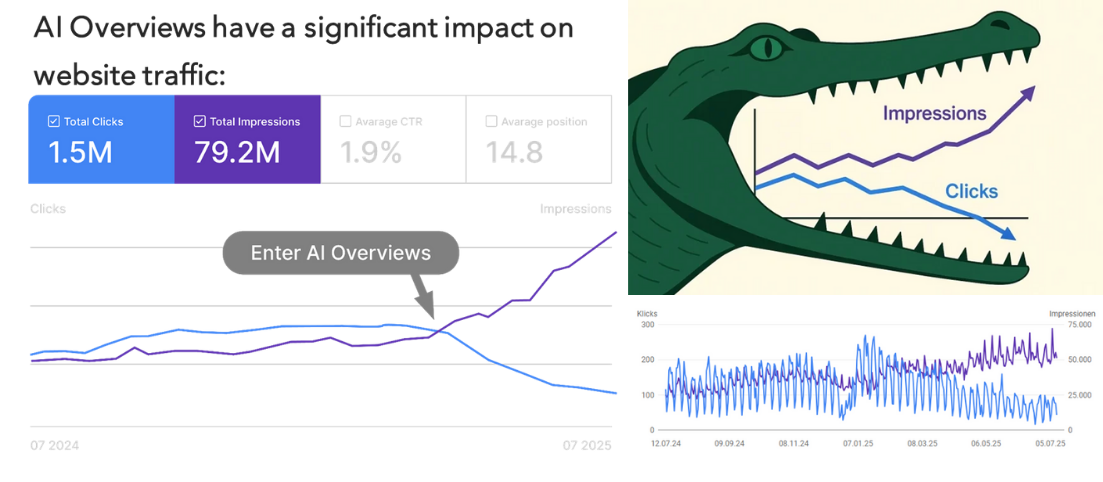
The result? A rise in “zero-click” searches and less visibility for brands within classic search result pages. On the flip side, brand mentions within AI-generated summaries are becoming more frequent, creating new touchpoints for awareness outside traditional metrics.
This shift presents marketers and SEOs with an entirely new challenge: How can we effectively position brands within these conversational, AI-driven answers? Understanding this shift is crucial because capturing user attention now goes far beyond clicks alone.
Three Key Dimensions to Measure AI’s Impact on Search Performance
To effectively navigate and benefit from the shift toward AI-driven search behaviours, brands need clear and actionable metrics. Traditional methods of assessing SEO and website performance no longer fully capture the nuances introduced by AI search tools like ChatGPT, Perplexity, or Google’s AI Overviews. Therefore, I’ve identified three practical dimensions for measuring AI’s real-world impact on your search visibility and traffic patterns:
1. Direct Traffic & Web Analytics
Unlike many paid analytics tools, Google Analytics 4 (GA4) is freely available to all website owners, making it an essential starting point for capturing traffic changes influenced by AI. Traditionally, traffic driven by AI chatbots or generative search results is challenging to isolate because it’s often recorded as direct or referral traffic without clear attribution. Similarly, Google Search Console (GSC) is another accessible tool that provides valuable insights into these AI-induced search patterns.
To identify potential AI-driven visits, start by examining your direct traffic closely. Look for sudden spikes or unusual patterns in your homepage traffic, especially shorter, exploratory sessions – as these can signal interactions originating from AI-generated answers.
In GA4, navigate to Reports > Acquisition > Overview and select the “Session – Source/Medium” view. Here, set up a custom filter using regular expressions to pinpoint AI referral sources. A suggested regex filter is:
- chatgpt|perplexity|gemini|claude|grok|x\.ai|mistral|deepseek|copilot
Regular monitoring of these filtered sessions can highlight emerging traffic sources and changes in user behaviour, helping you adjust content strategies proactively. For a more detailed and visual breakdown of the process in GA4, see the figures below.
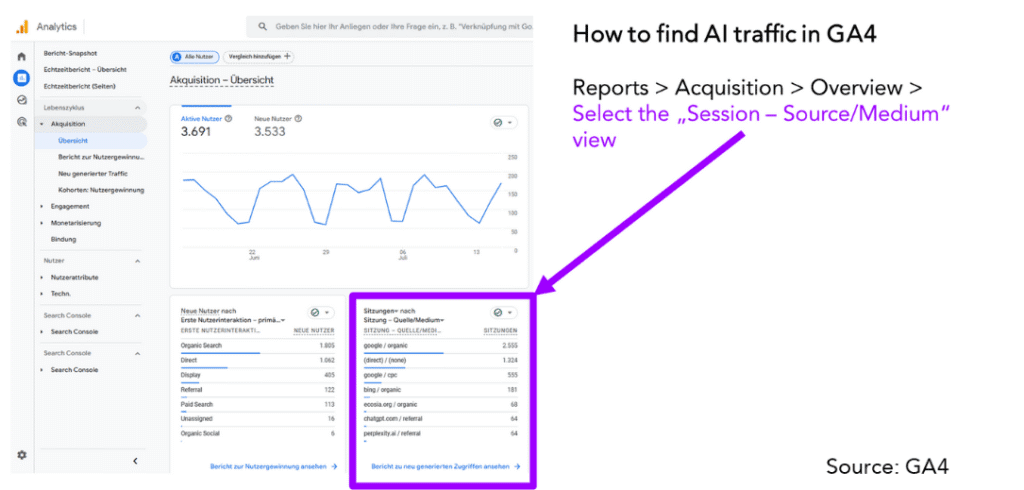

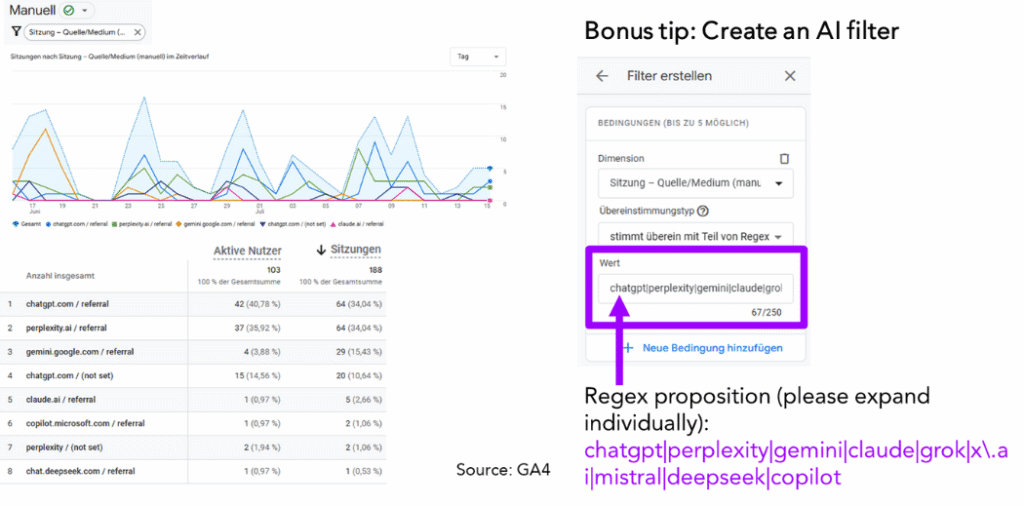
2. Search Visibility & Brand Signals in Google
For deeper insights, turn to Google Search Console (GSC), which currently offers the clearest indicators of how AI Overviews influence search performance.
Within GSC, closely observe changes in brand search impressions and clicks before and after the introduction of AI features. Compare key metrics in defined time periods – particularly before and after Google’s AI Overview rollout – to detect patterns, such as increases in impressions without corresponding clicks, indicative of the “Crocodile Mouth” effect.
Use GSC’s Performance Report and filter to your brand-specific keywords. Identify:
- Pages with high impressions but declining clicks, which may suggest content used in AI summaries without click-through.
- New patterns in branded searches, potentially driven by AI mentions in Google-generated summaries or chatbot answers.
For a detailed breakdown of how to identify relevant pages, see figures 5 to 7 below:
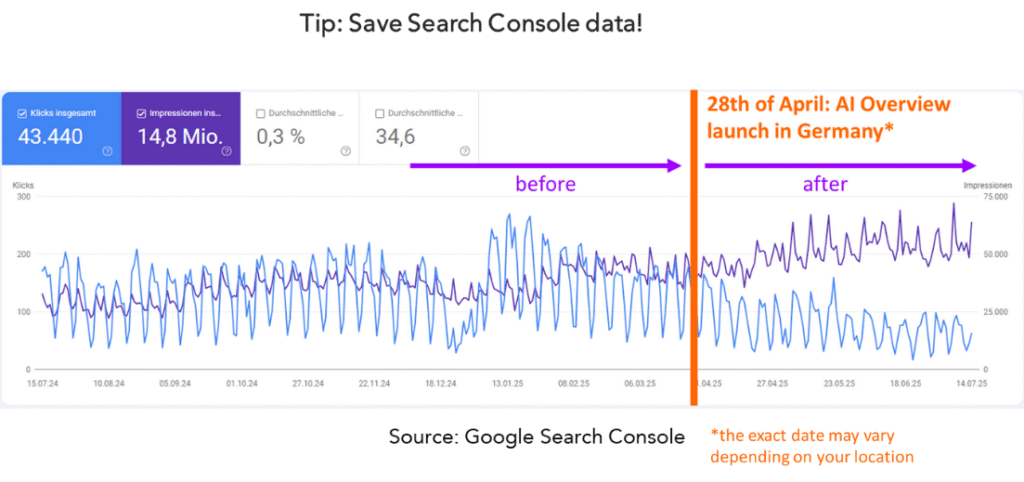
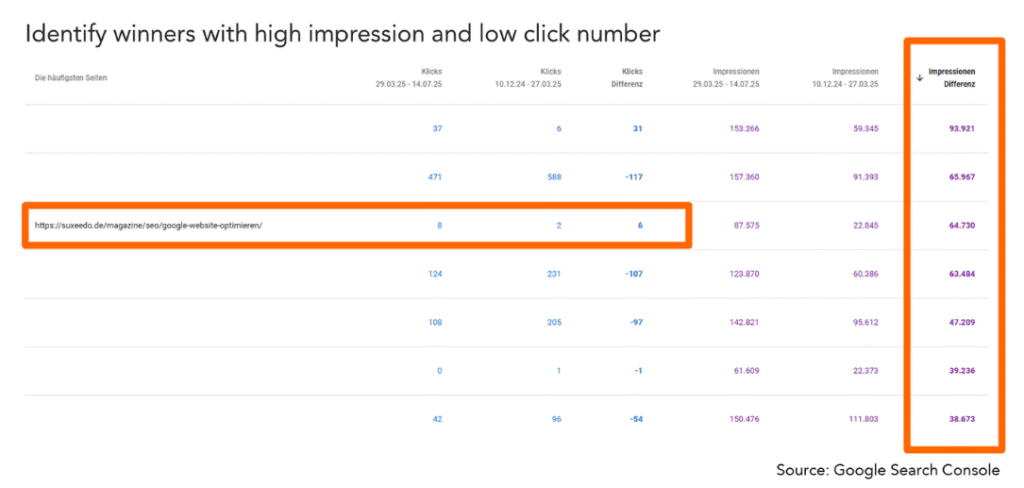
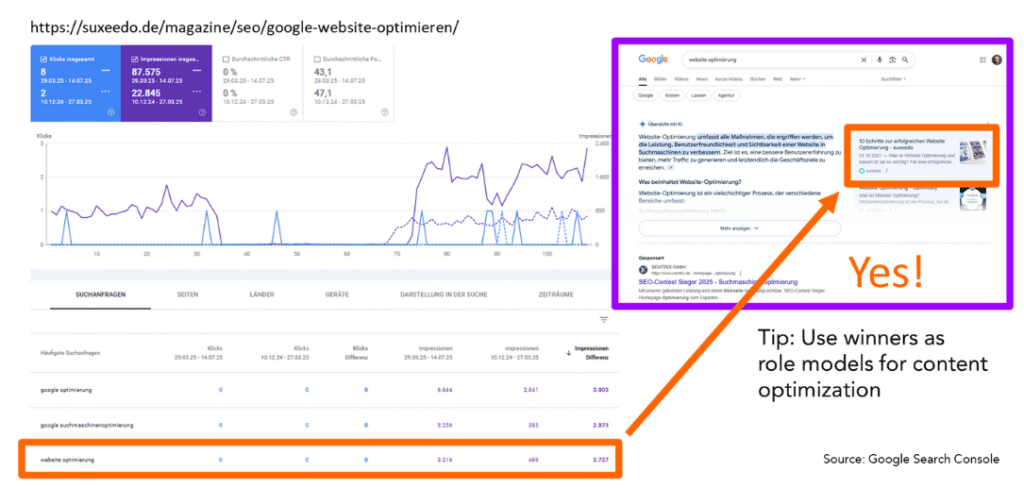
Regular comparison against your historical baselines is crucial to distinguishing typical fluctuations from AI-induced shifts. Documenting these insights will support strategic adjustments in content creation, technical SEO, and overall digital marketing efforts.
3. AI Mentions & Brand Sentiment in LLMs
The race for the best AI Search Insights platform has only just begun, with numerous emerging tools claiming unique strengths. However, from my practical experience, Peec AI currently stands out as a particularly effective platform for tracking brand visibility and sentiment across LLMs.
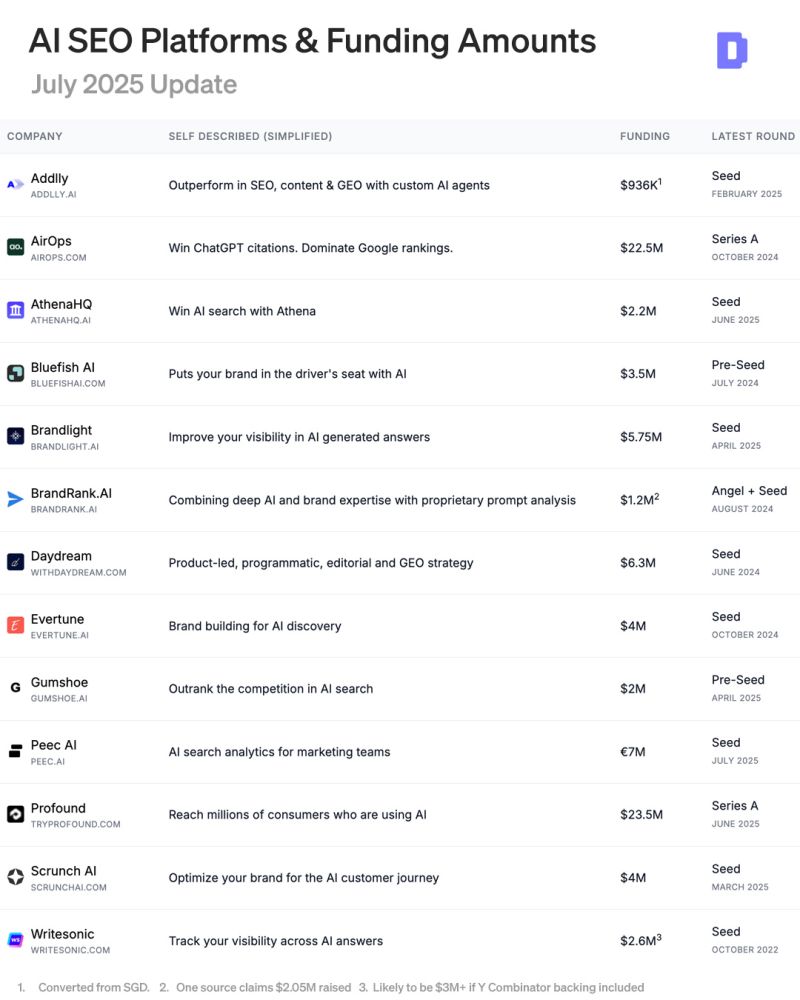
Platforms like Peec AI enable brands to monitor their visibility within AI-generated content systematically. By analysing mentions, sentiment, and citation frequency across multiple language models, Peec AI offers meaningful insights into how brands are positioned within conversational AI contexts.
To leverage these tools effectively, prompting is crucial. Craft targeted prompts around your brand, products, and industry keywords. Carefully formulated questions will yield clearer, more actionable insights:
- How frequently and positively is your brand mentioned?
- Which prompts yield the strongest visibility?
- Are certain content types more effective in gaining AI-generated mentions?
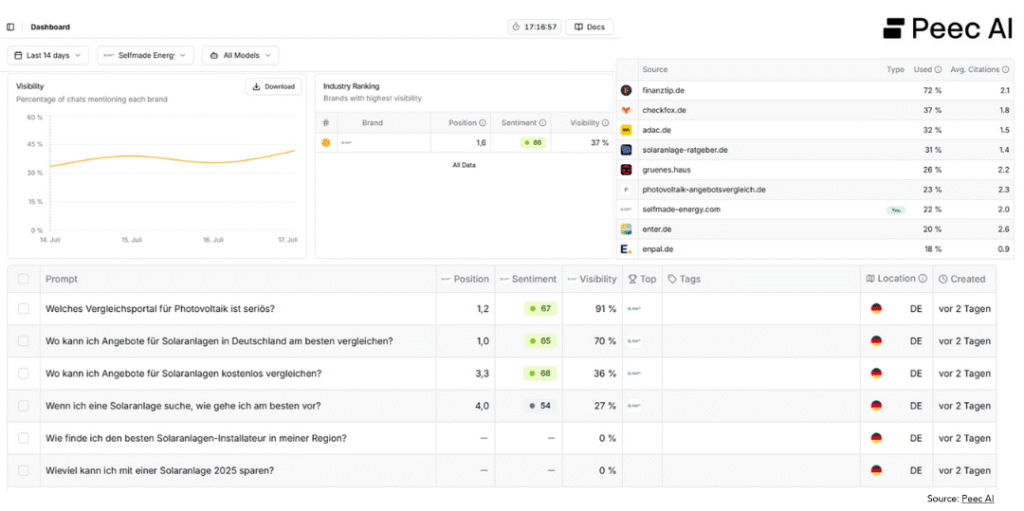
However, be aware of limitations. Current tools still rely heavily on prompt quality, making results dependent on input specificity and relevance. Nonetheless, platforms like Peec AI represent a valuable advancement, providing actionable insights despite these constraints.
Practical Implications & What Brands Should Do Now
Don’t Wait for Perfect Attribution Models – Work with What’s Visible
In a rapidly evolving AI search landscape, waiting for perfect attribution models or flawless analytics is not an option. Visibility today is better than guesswork tomorrow. Brands need to start tracking, interpreting, and acting upon currently available insights. Creating a practical, customised dashboard to track AI visibility provides clarity and immediate value.
One hands-on example is a dedicated AI Visibility Dashboard, which consolidates insights from accessible platforms such as Google Analytics 4 (GA4), Google Search Console (GSC), and AI monitoring tools like Peec AI. Such a dashboard can visually display AI-driven traffic, brand mentions, sentiment, and the channels contributing to these interactions – without overcomplicating the approach.
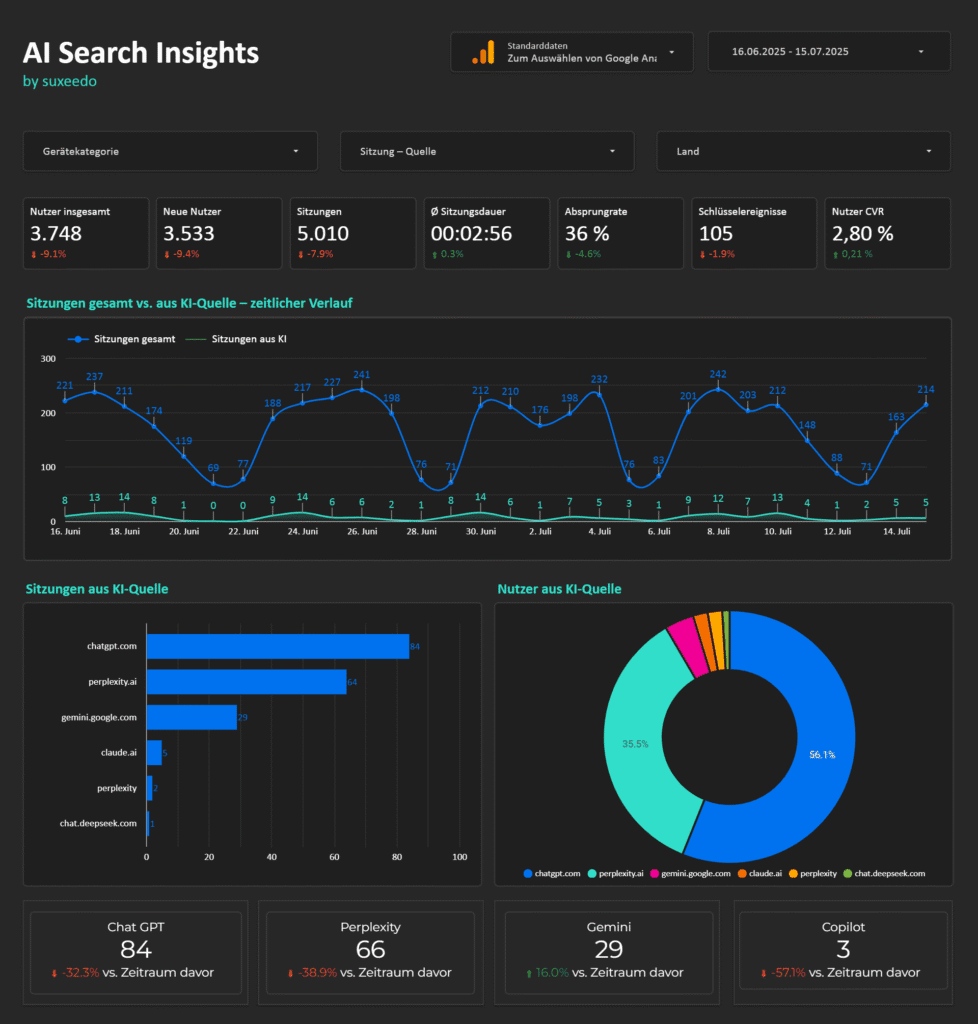
Rethink Performance KPIs: Awareness Over Clicks
Traditional KPIs such as clicks or direct conversions alone no longer fully represent success in the AI era. Brands must reconsider how they define performance, focusing on awareness, impressions, brand visibility, and sentiment as new critical metrics.
Key metrics include:
- Increase in brand impressions without direct clicks (the “Crocodile Mouth” phenomenon).
- Frequency and positivity of brand mentions in generative AI answers.
- Referrals and indirect traffic spikes indicate visibility within AI responses.
Adopting this new performance mindset ensures brands prioritise strategies that foster long-term visibility and trust, even without direct user clicks.
Track Consistently and Build Your Own Baselines
The introduction of generative AI requires consistent monitoring and proactive baseline creation. Historical comparisons become invaluable for distinguishing normal fluctuations from significant AI-driven changes.
To establish reliable baselines:
- Consistently record and analyse direct and AI-driven traffic metrics.
- Track brand sentiment and mention frequency in generative AI contexts.
- Regularly compare data against past performance, particularly at key milestones such as new AI feature releases by major platforms.
Clear, consistent baselines enable agile responses to evolving user behaviours, ensuring you’re informed, not surprised, by shifts in performance metrics.
Visibility Beyond Your Website: Off-Page SEO and Digital PR
Visibility in the AI-driven search era no longer solely depends on your own website’s content. Increasingly, off-page SEO, digital PR, and external platforms play a crucial role in brand discovery and recognition.
Whether you call it GEO (Generative Experience Optimisation), LLMO (Large Language Model Optimisation), AIO (AI Optimisation), or embrace a more inclusive definition like “Search Everywhere Optimisation,” the fundamental goal is clear: create authentic, trusted signals across various channels and platforms.
Such signals matter not only to traditional search engine crawlers but are increasingly relevant to AI-driven bots scanning for reliable and authoritative content. Examples include:
- Guest posts and expert articles on reputable platforms.
- Thought leadership through interviews and podcasts.
- Strategic digital PR efforts are generating high-quality backlinks and media mentions.
I personally refer to this as a consistent and compelling “signal story” that you’ll send out to search engine crawlers. Regarding the future of search: Telling this story across multiple touchpoints also builds trust among users and establishes your brand as a reliable source of information in the eyes of AI systems.
Coordinate SEO, Brand, and Content Teams More Closely
Success in the AI search landscape demands tighter integration among your SEO, Brand, and Content teams. Achieving this coordination practically involves:
- Joint Planning Sessions: Regular strategic meetings where teams align on content themes, keywords, brand messaging, and promotional plans.
- Shared Dashboards and Reporting: Commonly accessible dashboards like the AI Visibility Dashboard ensure all stakeholders see real-time performance metrics, enabling quick, unified decision-making.
- Unified Content Calendars: A single calendar ensures cohesive, consistent brand storytelling across various channels, platforms, and search contexts.
Through improved cross-team collaboration, brands can better synchronise their strategies, resulting in coherent, authentic narratives that resonate strongly with users and AI-driven search systems alike.
Final Thoughts: Navigating the AI-Search Shift with a Measurement Mindset
The AI shift in search isn’t merely an SEO challenge – it’s fundamentally about your brand’s visibility and how effectively you position yourself in a landscape dominated by instant, conversational answers. Brands must urgently pivot their mindset, tracking what can be seen now rather than waiting for ideal attribution models.
To stay ahead, you must proactively understand not just if, but precisely where and how your brand appears within the AI search ecosystem. Remember, authentic visibility in AI is built through consistent, authoritative narratives across multiple touchpoints. This is your “signal story,” crucial not only for AI crawlers but for building genuine trust with your audience.
Start right now with these three actionable steps:
- Set up your own AI Visibility Dashboard. Integrate available tools like GA4 and Google Search Console for actionable insights.
- Reassess your KPIs. Prioritise brand mentions, impressions, and sentiment over clicks alone.
- Coordinate immediately. Schedule a joint session between your SEO, Brand, and Content teams to unify your strategic approach and storytelling.
Your proactive measures today define your brand’s position tomorrow.
AI is rewriting the rules of search, and the implications extend far beyond rankings and clicks. For brands, success now depends on creating authentic visibility across multiple touchpoints, supported by consistent measurement and collaboration. By embracing new KPIs, building strong “signal stories,” and tracking AI-driven interactions, marketers can thrive in this evolving ecosystem. The message is clear: those who adapt early will shape the future of brand visibility in an AI-powered search landscape.
Join Us Now!
Ready to elevate your marketing strategy? Be part of our Upcoming Events – where innovation, networking, and cutting-edge insights meet in vibrant cities around the world. We can’t wait to welcome you in person!
Can’t attend in person? No problem. Join BEETc On-Screen, our On-Demand Learning Platform, for exclusive access to 500+ sessions and over 300 hours of content from global summits. Upskill at your own pace, gain actionable insights, and stay ahead in a rapidly evolving business landscape.
➡ Explore content from global summits! https://beetc.io/on-screen/
Stay up to date with our In Person Summit, Session Information, and Agenda Updates by following us on:
See more MarTech Thoughts Content/ Interview pieces here!
Last updated: August 2025



